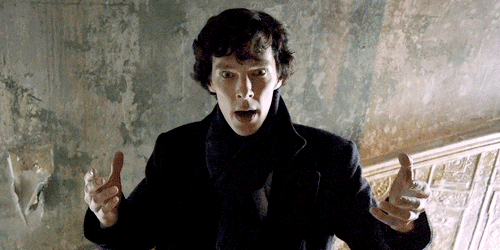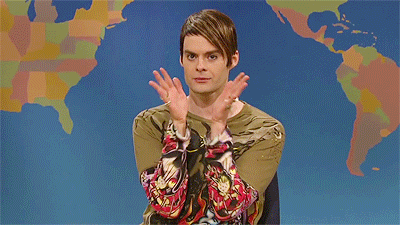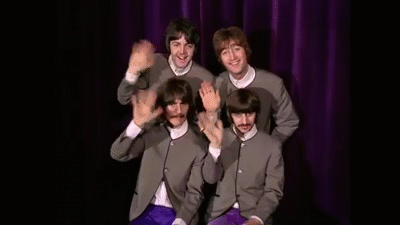“The play’s the thing,” Hamlet declares in Act II: Scene II of Hamlet, “Wherein I’ll catch the conscience of the king” (582-3). With this, Shakespeare’s titular character finally decides to take action after two full acts spent in a perpetual limbo of indecision. This moment in the play thus announces what looks like a definitive turning point for the hero and for the audience because the stage is set – all the players have been introduced and their motivations laid out – and it seems as if it is time for some action at last.
Well, the section that I read this week felt akin to this moment for me. Like things were really starting to come together and signal a forward push in the narrative. For the first time thus far in my journey into Infinite Jest, I felt like I was truly beginning to make connections – between all the characters, events, and tiny details mentioned earlier in the novel – and piece together a kind of bigger picture (albeit a fuzzy one).
Honestly, though, I had so many delightful “Aha!” moments when reading this latest page chunk.

For instance, I had three huge moments of revelation (resulting in a reaction not-so-unlike the one depicted in the gif above) prompted by the following occurrences:
- The discussion that the ETA boys have on pages 211-9 about DMZ, its infamous side-effects, and the necessity to sample it before “unleashing it” (216) on the general population that seems to suggest that this is what causes Hal to deteriorate and reduce him to his pitiful state in the opening pages. And, even if I’m wrong, it seemed to offer at least a potential explanation for what happens in Hal’s future.
- The one-two punch that Joelle van Dyne is not only Madame Psychosis, but also related to the Incandenzas in a major way (once-muse to Himself and ex-lover to Orin) that brings so many seemingly disparate threads together. If anything, the textual and paratextual (I’m looking at you, Footnote 80) sections focusing on Joelle are what really seem to tighten up the narrative while offering some more insight on the increasingly dysfunctional Incandenzas.
- The telephone conversation between Hal and Orin on pages 242-58 that fills the reader in on some of the graphic details of JOI’s suicide and the ways in which it has traumatized Hal (emphasis on ‘traumatized’). I felt as if their dialogue also fleshed out the strain in their relationship, pointed to the origins of different tensions within the family, and integrated yet another seemingly separate subplot by making reference to the Wheelchair Assassins.
Now, it is very possible that these connections were hinted at before now and that this first-time reader simply didn’t pick up on them; however, even if that is the case, I wanted to mark this week down as the one where I first felt a shift. Since IJ is a whopping 1079 pages (including the footnotes), perhaps it is only fitting that it takes nearly 300 of them to move from exposition to rising action.
Either way, this week’s reading left me with that same anticipation I always get at the end of Hamlet‘s second act when I know we’re about to move into the third one, which is my favourite because it’s when the plot really gets moving.
(If you’re drawing a blank on what exactly makes up act three of Hamlet, allow me to refresh your memory.
This act has everything.*

Dramatic break-ups. Guilt-trip plays. Teenage angst. Almost-murders. And… actual-murders!
Oh. There’s also Hamlet’s most iconic soliloquy, but I digress.)
Now, Phil talked about heroes in his post on Monday and how Wallace appears to critique the emergence of this new kind of hero that Hal describes in his essay as “the hero of non-action, the catatonic hero, the one beyond calm, divorced from all stimulus” (142, original emphasis). In his bleak depiction of all the characters who have dulled their ability to react and willed themselves into a state of non-action, DFW seems to hold up those who are brave enough to react as the real heroes of the narrative.
I’ve seen a few references to Hamlet thus far within Infinite Jest (most glaringly the title) and I sense it will continue to emerge as an important – if not the most important – intertext. I’m already seeing so many parallels between Hal and Hamlet, but that’s a bigger post for another time. What I will say to wrap up this post, though, is that, while Hamlet is famous for his inability to act and may seem at first glance to be the kind of prototypical hero of non-action described by Hal, he is actually one of the purest examples of a reactive hero. Despite being paralyzed time and again by indecision – weighed down by his brilliant mind that can’t seem to slow down – Hamlet is always reacting, always talking, always feeling. Almost all of his monologues and soliloquies are long laundry lists of his pain, of his anger, of his reactions to everything.
And even though it takes him a long time to do anything about it, Hamlet never stops reacting (and, in some cases, overreacting). But he’s a hero because of it – a tragic one – and his painfully human reactions still resonate with audiences even now.
What I see as I progress through IJ is an encouraging abundance of Hamlet-like heroes who continue to react even when they don’t want to. And, if this last section truly did signal the beginning of the rising action, I’m happy to be heading into this third act with heroes like Hal and Joelle (who I very much look forward to getting to know better and perhaps discuss next week).
Until then, goodnight, sweet princes and princesses! (Or good morning, or good afternoon depending on wherever you are in the world and whenever you choose to read this, of course.)

F O O T N O T E S
* I sincerely hope that you read that in Stefon’s voice. If not, please do me a favour and go back to read it again in your best mental approximation of it – I feel like it will make for a far funnier experience.
Now I can’t stop laughing at the thought of “litty correspondent” Sefon reviewing Infinite Jest!
LikeLiked by 1 person
Sorry, Stephon. I was laughing too hard! Make it stop!
LikeLiked by 1 person
Ha ha! Glad you found that bit funny. 🙂 Also, the thought of Stefon reviewing IJ is something I didn’t know I needed until now!
LikeLike
Okay… this is a wonderful post, Allie. It does cover everything! I don’t know that it quite feels like you’ve overlooked things yet, as much as it just all feels “familiar” by this point so the connections are clearer. I’m looking forward to any comparisons with Hamlet since I only half-remember it from high school.
LikeLiked by 1 person
Thank you so much, Time! Glad to hear from an IJ pro that I was able to cover mostly everything. It really felt good to start making some more rapid-fire connections this week! I think you’re on to something in that things definitely do feel “familiar” now, so maybe that’s the shift I felt. Either way, it feels like an accomplishment to be firing on all cylinders!
Ah, well I’m a total Hamlet nerd, so there’s a high likelihood that I’ll keep track of all the parallels to IJ in my future blog posts. I’m glad you’re looking forward to the continuation of Hamlet-palooza rather than dreading it! 😉
LikeLike
I’m also looking forward to hearing what others might have to say about the Hamlet connections in the book.
For me, I’ve always seen Hamlet as a device that is used to frame broad themes. For example, the central line of “to be or not to be” is arguably one of the most important questions that IJ seems to be grappling with in the book: how to go through life alive, or the importance of choice.
Also, both the play and the book are ghost stories of sorts. Both deceased fathers occupy a large part of the book, although they aren’t actually in the action. Their ghosts float just behind the scenes of the action of the main narrative(s).
Further, consider the analysis-paralysis problem that Hal and devotees of AA seem to have (Hamlet’s problem in the play?).
And someone has to mention it, so I will:
The first words of Hamlet, “Who’s there?”
The first words of Infinite Jest, “I am”
Probably not a coincidence, and a fun thing to think about. I’m not sure that I have a definitive answer for what it means. My guess would be that it has something to do with self-centeredness and the difficulty of getting free of it.
LikeLiked by 1 person
Eeeeeeh! I love that observation about the first words of IJ being the response to the first line of Hamlet. Thank you, Joe! With the title and all the little references within the text, that’s too perfect to be just a coincidence. DFW continues to astound with his cleverness!
As for what it all means? Well, I’ll only be able to offer my thoughts once I’ve finished the book, but if the novel – like the first words of IJ – is a response to Hamlet, then what is its answer? What is it answering in particular? The question of “To be or not to be?” (which I think you’re right in highlighting as a primary concern within IJ), or something else entirely? I’m not sure yet, but I’m excited to formulate an answer as I continue to read. 😀
Also, I love the thought of both IJ and Hamlet as ghost stories and the absent father. Definitely a huge connection!
Thank you for feeding my Hamlet obsession with more proof, Joe. I really appreciate it!
LikeLiked by 1 person
Another great post, Allie! Yes, please, note any Hamlet reference. I’m sure some of them are semi-obscure.
LikeLiked by 1 person
Thank you, Allan! Always great to hear from you. 🙂
I will be sure to keep noting any and all Hamlet references that I notice. It’s my favourite Shakespeare play (clichéd, but true) and I always jump at any excuse to get nerdy about it.
LikeLike